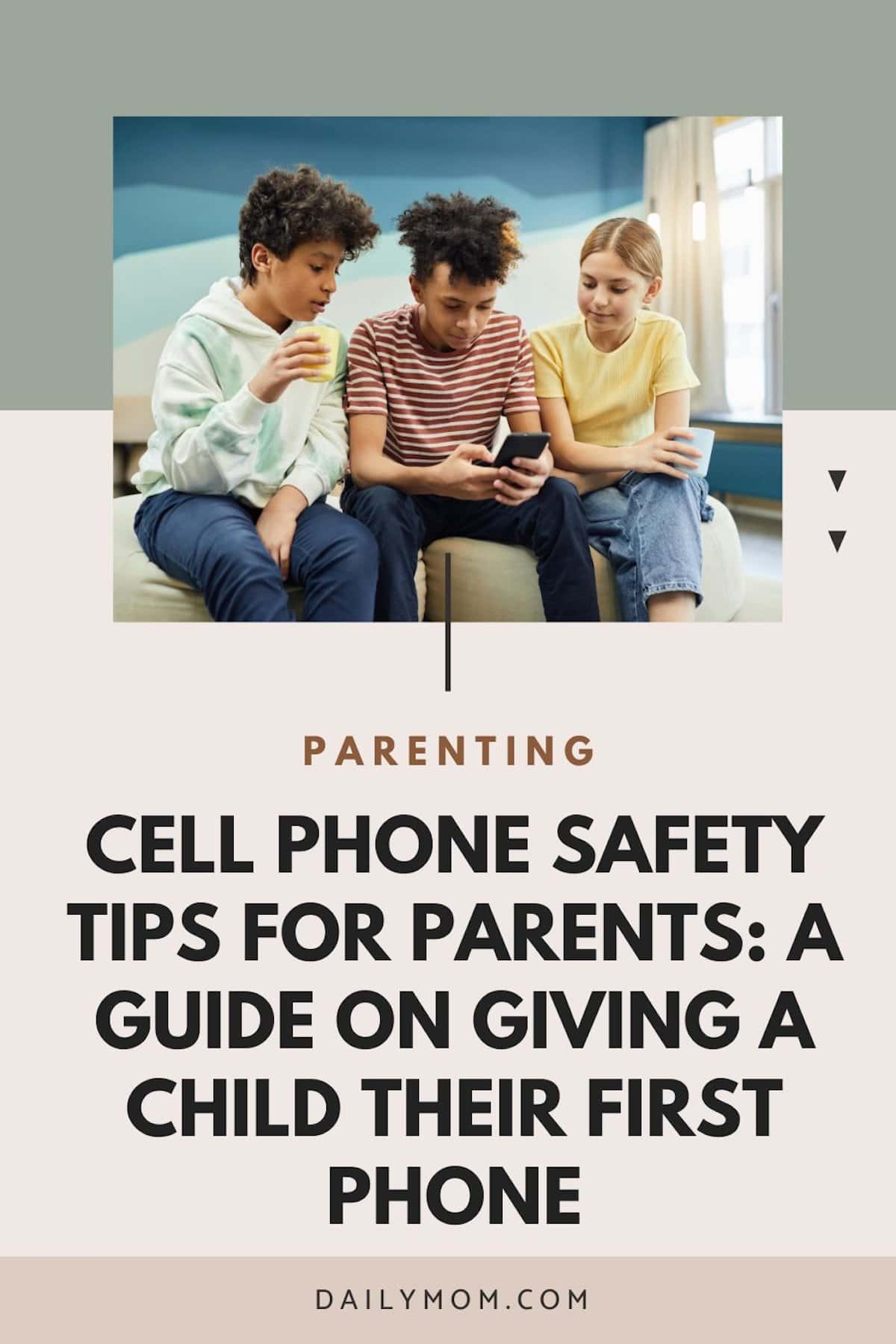In today’s digital era, the question of when to hand over your child’s first cell phone is a looming dilemma for many parents. With screens infiltrating every aspect of modern life, it’s no wonder we find ourselves pondering this decision earlier than ever before. As technology continues to evolve at breakneck speed, so too do the challenges and concerns surrounding its usage, especially for our little ones.
Let’s face it… we’re in an era where toddlers are swiping through apps with ease, pre schoolers are navigating YouTube like seasoned pros, 6th graders are chatting away on messaging apps, and tweens are SnapChat and TikTok pros. Welcome to the digital jungle where our kids roam freely, armed with gadgets that often seem to possess powers beyond our comprehension.
In this brave new world, the internet is both a playground and a minefield. This guide for parents and caregivers will be the ultimate solution for being able to access tips and tricks on giving their child a phone in this new digital age.

The Decision: Is It Time to Buy Your Child Their First Phone?
Ah, the perennial question that many parents grapple with: When is the right time to introduce our children to the world of cellular devices? It’s a decision fraught with uncertainty, balancing the allure of connectivity with the apprehension of potential risks. But how do we know when they’re truly ready to use the phone? While many parents may feel pressure to provide their child with one at a young age, it’s important to consider situations where a child doesn’t actually need one.
Age and Maturity Level: Is Your Child Ready?
One of the primary considerations is your kid’s age and maturity level. While there’s no magic number that dictates when a child should receive their phone, many pediatric professionals emphasize the importance of moderation, supervision, and age-appropriate technology.
For some children, the allure of owning a device may be strong from a young age, driven by peer pressure or the desire to stay connected with friends and family. However, it’s essential to evaluate whether they possess the maturity to handle the responsibilities that come with owning a device.
Consider factors such as their ability to follow rules, make responsible decisions, and understand the consequences of their actions. Are they capable of managing their usage effectively and navigating technology in a safe and respectful manner? These are crucial questions to ponder as you weigh the decision to entrust them with their first device.
Furthermore, age alone shouldn’t be the sole determining factor. While some children may demonstrate maturity beyond their years, others may require a longer period to develop the necessary skills and judgment. As a parent, it’s vital to assess your child’s individual readiness and provide guidance and support accordingly.
Read More: Five Tips To Save Money on your Cell Phone Service
Communication, Safety, and Responsibility
When contemplating buying your child a phone, it’s crucial to consider the primary purpose behind the decision. Are you primarily looking to provide them with a means of communication, ensuring they can stay in touch with you and other trusted contacts? Or are safety concerns driving your decision, with the device serving as a lifeline in case of emergencies?
Understanding it’s intended purpose can help clarify your expectations and guide your approach to setting boundaries and rules. If communication is the primary goal, you may prioritize features such as text messaging and calling while limiting access to apps and internet browsing. On the other hand, if safety is paramount, you might opt for a device equipped with GPS tracking and emergency contact capabilities.
Moreover, introducing your child to using a phone is an opportunity to instill a sense of responsibility and teach them about the importance of digital citizenship. By setting clear rules for device usage and discussing topics such as privacy, online etiquette, and cyberbullying, you can empower your child to navigate the digital world safely and responsibly.
Ultimately, the purpose of the device should align with your family’s values and priorities, ensuring that it serves as a valuable tool for communication, safety, and personal growth. As we delve deeper into this topic, we’ll explore practical tips and strategies for harnessing the power of technology while fostering a healthy and balanced relationship with screens.
Setting Expectations and Boundaries
Before handing over a phone to your child, it’s essential to engage in open and honest discussions as a family about the expectations and boundaries surrounding its usage. This isn’t just about laying down the law; it’s an opportunity to establish mutual understanding, trust, and respect regarding using cell phones within your household.
Start by outlining the purpose of the device and the reasons behind your decision to give it to your child. This can help contextualize the rules you’ll be putting in place and foster a sense of ownership and responsibility on their part.
Next, collaboratively establish clear expectations for device usage, covering aspects such as screen limits, appropriate content and apps, and device etiquette. Encourage your child to voice their thoughts and concerns, and be willing to negotiate and compromise where necessary.
Parents and caregivers should consider drafting a family tech agreement together, outlining the rules and consequences for violating them. This document can serve as a reference point for both parents and children and provide a framework for ongoing discussions about tech usage.
Additionally, emphasize the importance of digital safety and privacy, educating your child about potential risks such as online predators, cyberbullying, and oversharing personal information. Encourage open communication and assure them that they can come to you with any concerns or incidents they encounter online.
By involving your child in the process of setting expectations and boundaries, you’re not only empowering them to make responsible choices but also fostering a sense of trust and accountability within your family dynamic. As we delve deeper into this topic, we’ll explore practical strategies for implementing these rules and navigating the challenges of parenting in the digital era.

Choosing the Right Device
Alright, so you’ve decided to take the plunge and buy your kid a mobile phone. But with a bazillion options out there, how do you pick the right one? Don’t worry, we’ve got your back. Let’s break it down into bite-sized pieces.
Smartphone vs. Feature Phone: What’s the Best Fit?
Alright, so you’re standing in the tech aisle, staring down rows of sleek smartphones and old-school flip phones. Do you go full-on smartphone or opt for the simpler feature devices?
Let’s break it down. Smartphones are like pocket-sized computers, offering access to apps, games, the internet—you name it. They’re great for staying connected, completing homework on the go, and, let’s be real, wasting away with endless TikTok scrolls.
But with great power comes great responsibility, right? Kids need to know that smartphones can be a bit of a double-edged sword. Sure, they’re super handy, but they also come with potential pitfalls—like distractions galore and the temptation to overshare on social media.
On the flip side (pun intended), there’s trusty old feature phones. These babies are all about the basics: calls, texts, maybe a game of Snake if you’re feeling nostalgic. They’re perfect for kids who just need a way to stay in touch without all the bells and whistles of a smartphone.
Feature phones are often more durable and have better battery life, making them a solid choice for younger kids or those prone to losing or breaking things (we’ve all been there).
Ultimately, it comes down to what your kid needs (and what you’re comfortable with). If they’re responsible enough to handle a smartphone and you’re cool with setting some boundaries and parental regulations, go for it. But if you’d rather keep things simple and minimize distractions, a feature phone might be the way to go.
Either way, you’re giving your kid a way to stay connected and giving yourself a little extra peace of mind. And hey, that’s what it’s all about, right?
Finding a Device That Works for Your Budget
Alright, let’s talk dollars and cents. Buying your kid a phone doesn’t have to break the bank, but it’s important for parents to find a device that fits their budget while still meeting their needs.
Set a budget that works for you. Whether you’re splurging on the latest iPhone or sticking to a more modest price range, having a clear idea of what you’re willing to spend can help narrow down your options.
Next, consider whether you’re buying new or used. While a shiny new device might be tempting, don’t overlook the value of a gently refurbished device. You can often snag a great deal on a refurbished phone or a hand-me-down from a family member or friend.
Keep an eye out for sales and promotions, too. Many carriers offer discounts on devices when you sign up for a new plan, so it’s worth shopping around to see what deals are out there.
And hey, don’t forget about ongoing costs like monthly service fees and data plans. Factor these into your budget to ensure you’re not in for any surprises down the line.
At the end of the day, finding the right phone is all about striking a balance between features, quality, and affordability. So do your research, and remember: the perfect device is out there, no matter your budget.
Features to Look For: Parental Controls, Durability, and More
When it comes to picking the perfect phone for your kid, there are a few key features you’ll want to keep an eye out for. Begin by looking at parental controls. These bad boys are your best friend when it comes to keeping your kid safe and sound in the digital world. Look for devices that offer robust regulation options, allowing you to manage things like screen limits, app permissions, and website restrictions.
Next, let’s talk durability. Kids aren’t exactly known for their gentle touch, so you’ll want a phone that can stand up to a few bumps and bruises. Consider options with reinforced frames, scratch-resistant screens, and maybe even waterproofing for those inevitable spills and splashes.
Battery life is another biggie. There’s nothing worse than a dead phone when you need to get in touch with your kid, so look for devices with long-lasting batteries that can go the distance.
And hey, don’t overlook the importance of storage space. Between apps, photos, and videos, your kid’s phone is bound to fill up fast. Make sure you opt for a device with plenty of storage or the option to expand with a microSD card.
Other features to consider include camera quality (because who doesn’t love a good selfie?), ease of use (no one wants to spend hours explaining how to use their phone), and of course, the all-important price tag.

Cell Phone Safety Tips for Parents: Setting Guidelines and Boundaries
Navigating the digital landscape with our kids can feel like traversing uncharted territory, fraught with endless possibilities and potential pitfalls. In this ever-connected world, where screens beckon with their allure and distractions lurk around every corner, setting the stage for responsible device usage is paramount. By laying down the law with a mix of firmness and flexibility, we can empower our children to navigate the digital realm with confidence and integrity, fostering habits that will serve them well for years to come.
Balancing Phone Usage Limits
In today’s digital era, it’s all too easy for our kids to be sucked into the endless abyss of their screens, whether they’re scrolling through social media, binge-watching videos, or gaming until the wee hours of the morning. But as tempting as it may be to let them while away the hours in front of their devices, it’s essential to strike a balance between using their tech and other activities.
To begin, set some ground rules. Establish daily or weekly limits on their phone activity, taking into account factors like how old they are, schoolwork, and extracurricular activities. Consider using apps or built-in device features to track and manage your child’s phone usage, helping them develop healthy habits from an early stage.
But it’s not just about quantity; it’s also about quality. Encourage your child to engage in a diverse range of activities beyond the screen, whether it’s playing outside, reading a book, or pursuing hobbies and interests. By providing opportunities for physical activity, creativity, and social interaction, you can help them develop a well-rounded lifestyle that extends beyond the amount of time they spend on their mobile device.
And hey, lead by example. Show your child that you value being away from screens by setting boundaries for your own device usage and actively participating in offline activities together as a family. After all, the best memories are made when we’re fully present and engaged with the world around us—not staring at a screen.
Being Safe Online: Age-Appropriate Apps and Media
When it comes to content consumption, ensuring that your child has access to age-appropriate apps and media is crucial for their development and well-being. With the vast array of content available online, from educational apps to entertaining videos, it’s essential to curate a digital environment that aligns with your family values and your child’s interests.
Start by doing your research. Explore reputable sources for age-appropriate apps, games, and videos that are both engaging and educational. Look for content that is designed specifically for your child’s maturity level and that promotes positive values such as kindness, creativity, and critical thinking.
But don’t stop there. Take an active role to monitor and limit your child’s media consumption, reviewing the content they’re accessing and discussing any concerns or questions that arise. Encourage them to ask for permission before downloading new apps or accessing unfamiliar websites, and be proactive about setting controls to filter out inappropriate content.
And remember, it’s okay to say no. Not every app or game is suitable for every child, and it’s essential to trust your instincts and set boundaries accordingly. By fostering open communication and providing guidance and support, you can help your child make informed choices about their media consumption and develop habits that will serve them well.
Responsible Cell Phone Usage: Discussing Text Messages, Online Safety and Etiquette
Teaching our kids about online safety and etiquette is as essential as teaching them to look both ways before crossing the street. From avoiding online bullying to safeguarding personal information, there are a host of digital dos and don’ts that every child should know as they use their device.
Start by making sure they know that they can have an open and honest conversation about online safety. Discuss the importance of never sharing personal information with strangers, being cautious about who they talk to online, and recognizing warning signs of potential threats. Encourage your child to trust their instincts and come to you if they ever feel uncomfortable or unsafe online.
But it’s not just about protecting themselves—it’s also about respecting others. Teach your child about the golden rule of online etiquette: treat others as you would like to be treated. Emphasize the importance of being kind, respectful, and considerate in their interactions with others, whether they’re chatting with friends, commenting on social media, or participating in online forums.
And don’t forget to lead by example. Show your child what responsible online behavior looks like by modeling them yourself. Practice safe browsing, avoid oversharing personal information, and think twice before posting or commenting online.
By instilling these values early on, you can help your child navigate the digital world with confidence and integrity, fostering a positive and respectful online community for themselves and others.

Keeping your Child’s Phone Safe: Using Parental Controls and Monitoring Tools
Ensuring the safety and well-being of our children online has become a top priority for parents everywhere. With the vast array of content and platforms available at their fingertips, it can be challenging to keep track of what our kids are doing online and ensure they’re engaging in safe and appropriate behavior. That’s where controls and monitoring tools come in. By leveraging these powerful tools, parents can take proactive steps to protect their children from online threats, manage their screen usage, and guide them towards responsible digital citizenship.
Getting Built-in Regulations & Third-Party Apps
When it comes to implementing regulations and monitoring tools, parents have a plethora of options at their disposal. Many devices come equipped with built-in features that provide parents the ability to manage and monitor how their child is able to access the internet, while some third-party apps offer additional functionalities and customization options. For instance, give these third-party apps a try:
Privacy Settings & App Restrictions
Setting up and customizing regulations is a crucial step in ensuring your child’s safety and well-being in the digital world. Start by exploring the privacy settings on your children’s phones, where you can adjust parameters such as location tracking, data sharing, and online visibility. Next, take advantage of app restrictions to filter out age-inappropriate content, limit access to certain apps or websites, and set usage limits. By tailoring these to your child’s individual needs and maturity level, you can create a safe and nurturing digital environment that will allow kids to partake in responsible online behavior.
Monitoring Your Child’s Activity: Strike a Balance Between Trust and Oversight
Here’s the thing: it’s essential to strike a balance between being the cool, laid-back parent and the vigilant guardian of internet safety.
Sure, you want to trust your kid to make the right choices online, but a little oversight never hurt anybody. So, keep an eye on things without being too overbearing. Think of it more as having their back rather than snooping on their every click.
Talk to your kid about why you’re setting up these boundaries and what they mean. Let them know it’s not about spying but about making sure they’re staying safe and making smart choices online.
And hey, while you’re at it, use this as an opportunity to have some real talk about internet safety and responsible online behavior. Set some ground rules, lay down the law, but also let them know you’ve got their back no matter what.
So, go ahead, check in every once in a while, but don’t forget to give your kid some space to explore and learn on their own. After all, finding that balance is what parenting is all about.

Having Open Conversations with Your Child
Navigating the digital landscape with our children isn’t just about how parents can track and monitor their online activity—it’s also about fostering open and honest communication. In an age where screens dominate so much of our daily lives, having meaningful conversations with our kids about their digital experiences is more important than ever. From discussing online safety and etiquette to exploring their interests and concerns, these conversations provide valuable opportunities to connect, educate, and empower our children to make smart choices online. Let’s dive into the importance of having open conversations with your child about their digital lives and share tips for fostering healthy communication.
Teach Your Child to Protect Their Information
Safeguarding personal information is paramount. From social media profiles to online gaming accounts, our children’s digital footprint is more extensive than ever before. That’s why it’s crucial to educate them about the importance of privacy and security from an early age.
Start by having a frank discussion about the types of information that should never be shared online, such as full names, addresses, cell numbers, and passwords. Emphasize that once something is shared online, it can be challenging to manage who sees it and how it’s used.
Teach your child how to recognize and avoid phishing scams, malware, and other online threats. Show them how to identify secure websites and use strong, unique passwords to protect their accounts.
Encourage them to think critically about the information they share online and the potential consequences of oversharing. Remind them that it’s okay to say no to requests for personal information and to trust their instincts if something feels off.
Online Etiquette, Bullying, and Cyberbullying: Empowering Your Child to Navigate Social Media
In the vast world of social media, online forums, and messaging apps, interactions can sometimes take a negative turn. Online bullying, in particular, has become a prevalent issue, with harmful comments and behavior lurking behind screens. It’s essential to equip your child with the tools to recognize and respond to online bullying and navigate online interactions with empathy and respect.
Start by having open conversations about online bullying and its impact. Teach your child to recognize the signs of online bullying, such as hurtful comments, exclusion, or harassment, and encourage them to speak up if they witness or experience it themselves.
Emphasize the importance of treating others with kindness and respect online, just as they would in person. Teach them to think before they post, to consider how their words and actions may affect others, and to stand up for themselves and others if they encounter online bullying.
Encourage your child to be mindful of their digital footprint and to think carefully about the content they share online. Remind them that once something is posted online, it can be challenging to remove or manage its spread.
By empowering your child with the knowledge and skills to navigate social interactions online, you can help them develop resilience, empathy, and confidence in their digital lives.
Read More: Cyberbullying and How it Might Affect your Child

Dealing with Challenges and Concerns with Phone Use
As parents, navigating the ever-evolving digital landscape alongside our children comes with its fair share of challenges and concerns. From online safety and screen usage management to online bullying and privacy issues, the digital world presents a myriad of potential pitfalls that can leave us feeling overwhelmed and uncertain. However, by arming ourselves with knowledge, fostering open communication, and implementing proactive strategies, we can tackle these challenges head-on and empower our children to thrive out in that big ol’ world.
Addressing Device Addiction: Strategies for Healthy Screen Time Habits
The allure of screens can be hard to resist for both children and adults alike. With smartphones, tablets, and computers at our fingertips, it’s easy to find ourselves glued to screens for hours on end. However, excessive screen usage can have negative effects on our physical and mental health, leading to issues such as eye strain, poor posture, sleep disturbances, and even anxiety or depression.
To address device addiction and promote healthy screen usage habits, it’s essential to set boundaries and establish routines that prioritize balance and moderation. Start by designating screen-free hours and zones in your home, such as during meals, before bedtime, and in bedrooms. Encourage your child to engage in alternative activities, such as outdoor play, reading, or creative pursuits, to reduce reliance on screens for entertainment.
Additionally, consider implementing screen usage limits or using apps and controls to manage and monitor your child’s device usage. Set clear expectations for acceptable screen usage behavior and consequences for exceeding limits or engaging in unhealthy habits. Model healthy habits yourself by limiting your own device usage and prioritizing being with your family.
Handling Cyberbullying or Inappropriate Content: Establishing Communication Channels
Cyberbullying and encountering inappropriate content online are unfortunate but all too common experiences for many children. As parents, it’s crucial to create a safe space for your child to communicate openly about any concerns or issues they encounter online. Establishing clear communication channels is key to addressing these challenges effectively.
Start by fostering an environment of trust and openness, where your child feels comfortable coming to you with any worries or problems they may have. Let them know that you’re here to listen and support them, without judgment or blame.
Encourage your child to be vigilant about their online interactions and to speak up if they experience online bullying, harassment, or encounter inappropriate content. Teach them how to block or report abusive users and to keep evidence of any harmful behavior for reference.
Regularly check in with your child about their online experiences and actively listen to their concerns. Validate their feelings and reassure them that they’re not alone in dealing with these challenges.
Work together to develop strategies for coping with online bullying or inappropriate content, such as blocking or unfollowing negative individuals, reporting abusive behavior to the appropriate authorities, and taking breaks from social media or online platforms when needed.

In wrapping up this journey of your child diving into the world of cellular devices, it’s evident that safety has been a recurring theme. From navigating the digital landscape to fostering responsible habits, the underlying goal has always been to ensure their well-being in this interconnected realm. As they embark on this new adventure, equipped with their shiny device, it’s essential to remember that with great connectivity comes great responsibility.
By setting clear boundaries, having open conversations, and leveraging available tools for monitoring and protection, we can provide our children with the guidance and support they need to navigate the digital world safely and responsibly. So, here’s to embracing the opportunities that technology offers while prioritizing the safety and security of our children every step of the way.
WANT TO READ MORE?
Dive into 8 Tech Breakthroughs for Modern Moms: Discover the Top Advances Revolutionizing Parenthood with Smart Home Technology
CONNECT WITH DAILY MOM
💖 NEWSLETTER: DAILY READS IN YOUR INBOX 💖
Sign up to receive our picks for the best things to do, see and buy so you can relax and focus on more important tasks! Let us help you be the best version of yourself you can be!
BE SOCIAL WITH US
📌 LOVE IT? PIN IT!📌

